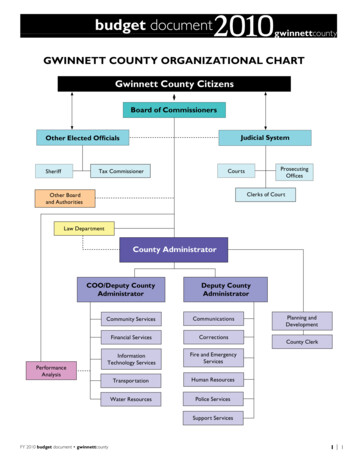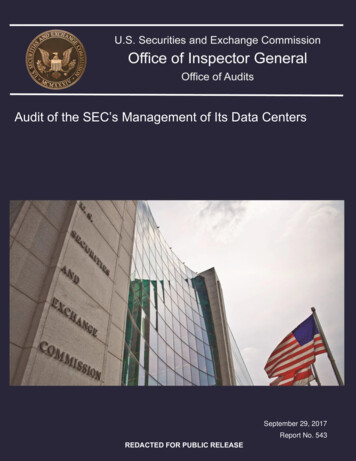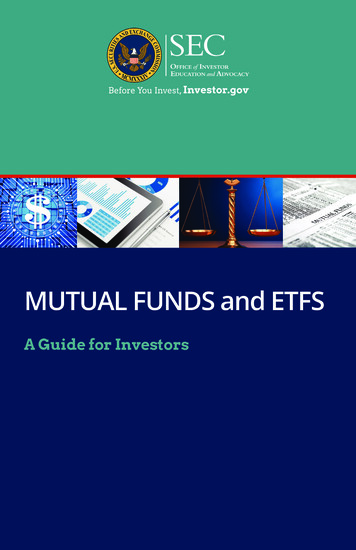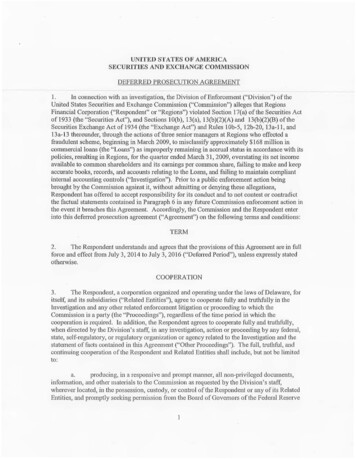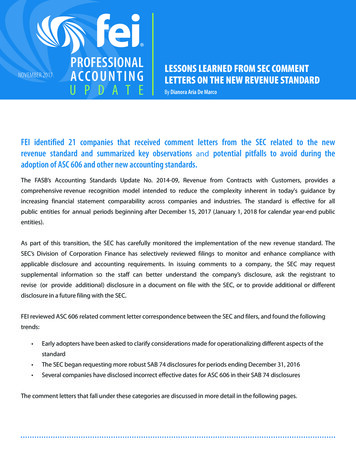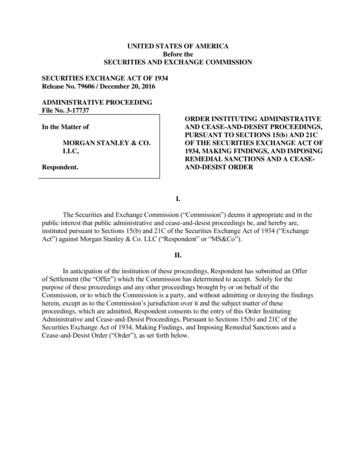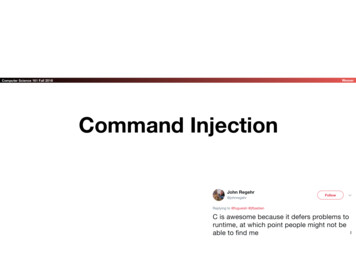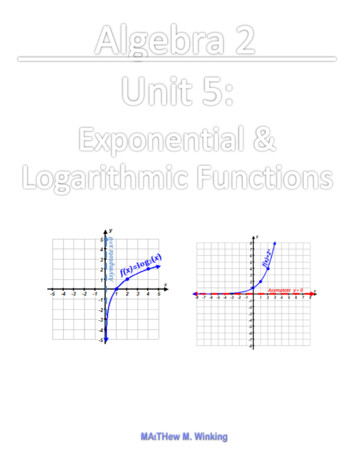
Transcription
Sec 5.1 – Exponential & Logarithmic Functions(Exponential Models)Name:1. The population of the city Suwanee, GA has consistently grown by 4% forthe last several years. In the year 2000, the population was 9,500 people.What would be the growth factor (multiplier)?If the trend continues what would be the population in 2020?2. Lisa purchases a house for 150,000 near Lake Jackson. The value of houses in thearea where the house was purchased is averaging an increase of 6% per year.What would be the growth factor (multiplier)?If the trend continues how much would the house beworth 12 years after Lisa purchased the house?3. Esther purchased a used car, a Ford Focus, for 8400. The car is expectedto decrease in value by 20% per year over the next couple of years.What would be the decay factor (multiplier)?If the trend continues how much would the car beworth 6 years after Esther purchased the car?4. Freddie purchased a pair of never worn Vintage 1997 Nike Air Jordan XII Playoff Black VarsityShoe Size 12 for 380. The shoes have shown an average growth rate of 14% per year.What would be the growth factor (multiplier)?If the trend continues how much would the shoes beworth 5 years after Freddie purchased the shoes?5.A culture of bacteria triples by the end of each hour. There were initially 50bacteria present in the petri dish.What would be the growth factor (multiplier)?If the trend continues how many bacteria would therebe 5 hours after the analysis began?M. WinkingUnit 5-1 page 79
6. Consider starting with 2 pennies. Flip them both and for each one that lands heads up, add a penny to the pile.So, the pile should increase in size. Again, flip the new pile of pennies which could be a size of 2, 3, or 4. Forevery penny that lands heads up add another penny to the pile. Repeat this process several times and recordhow the penny pile grows after each flip. Your values may differ on Flips 3 and 4.Number of FlipsNumber of Pennies021325Flip #1Add a penny since thisone landed heads up.34Flip #2Add a pennysince this onelanded heads up.Add another penny sincethis one landed heads up.567Create a graph of the data.a. What is an appropriate growth factor (multiplier)?Number of Coinsb. Create an equation that describes the relationship betweenthe number of flips and the number of pennies in the pile.c. Approximately how many pennies would there be on the 9th flip?d. Should the graph be continuous or discrete? Explain.e. What is an appropriate Domain and Range for the situation?Number of Coin FlipsM. WinkingUnit 5-1 page 80
7. Determine which of the following functions are exponential models of Growth and which are models of Decay.a.𝑓(𝑥) 2 (1.05)𝑥Circle the AnswerGrowthDecay Neither7 𝑥d. 𝑦 230 (5)Circle the AnswerGrowthDecay Neither14g. 𝑦 (3)𝑥Circle the AnswerGrowthDecay Neither3 𝑥b. 𝑔(𝑥) 540 (0.92)𝑥 1c. ℎ(𝑥) 4 (5)Circle the AnswerCircle the AnswerGrowthGrowthDecay Neithere. 𝑦 4200 𝑒 𝑥 5f. 𝑦 9 (2) 𝑥Circle the AnswerCircle the AnswerGrowthGrowthDecay Neitherh. 𝑝(𝑥) 520 𝑒 𝑥 3i.Decay Neither2 𝑥5𝑦 230 ( )Circle the AnswerCircle the AnswerGrowthDecay NeitherGrowthDecay Neither𝒓 𝒏𝒕8. Consider the Compound Interest Formula: 𝑨 𝑷 (𝟏 )𝒏a. Determine the value of an account in which a personinvested 6000 for 12 years at an annual rate of 9%compounded annually (n 1).Decay NeitherA Value of Account after CompoundingP Original Amount Investedr Annual Interest Rate as a decimaln Compounds per Yeart Number of Years Interest is Accruedn 1 :Annuallyn 2 :Semi-Annuallyn 4 :Quarterlyn 12 :Monthlyn 52 :Weeklyn 365 :Dailyb. Determine the value of an account in which a person invested 6000 for 12 years at an annual rate of 9%compounded quarterly (n 4).c. Determine the value of an account in which a person invested 6000 for 12 years at an annual rate of 9%compounded weekly (n 52).9. Consider the Compound Interest Formula: 𝑨 𝑷 𝒆𝒓𝒕Determine the value of an account in which a person invested 6000 for12 years at an annual rate of 9% compounded continuously.A Value of Account after CompoundingP Original Amount Investedr Annual Interest Rate as a decimalt Number of Years Interest is Accrued
Sec 5.2 – Exponential & Logarithmic Functions(Graphing Exponential Functions)1. Consider the exponential function , 𝑓(𝑥) 3𝑥 .A. Fill in the missing values in the table below.xName:B. Plot the points from the table and sketch a graphLabel any asymptotes.f(x)2027C. Determine the Domain &Range of the function.1–1–32. Consider the exponential function , 𝑔(𝑥) 2𝑥 2.A. Fill in the missing values in the table below.xB. Plot the points from the table and sketch a graphLabel any asymptotes.g(x)2300C. Determine the Domain &Range of the function.–1–31 𝑥3. Consider the exponential function , ℎ(𝑥) (2) 1.A. Fill in the missing values in the table below.xB. Plot the points from the table and sketch a graphLabel any asymptotes.h(x)–3–101C. Determine the Domain &Range of the function.23M. WinkingUnit 5-2 page 82
4. Determine the asymptote and sketch a graph (label the any intercepts, points when x 0, and when x 1.)𝑥A. 𝑓(𝑥) 3𝑥 4B. 𝑔(𝑥) ( 12 ) 2C. ℎ(𝑥) 2𝑥 35. Create two different exponential functions of theform 𝑓(𝑥) 𝑎 𝑏 𝑥 𝑐 that have a horizontalasymptote at 𝑦 5.7.Consider t(x) is of the form 𝑡(𝑥) 𝑎 𝑥 𝑐.Which of the following must be true for the parameter ‘a’?a 10 a 1a 0Which of the following must be true for the parameter ‘c’?c 0c 0c 0M. Winking6. Given the function 𝑓(𝑥) is of the form 𝑓(𝑥) 𝑎 𝑏 𝑥 𝑐 ,has a horizontal asymptote at 𝑦 1, and passes throughthe point (0,2), create a possible function for 𝑓(𝑥).8.Consider w(x) is of the form 𝑤(𝑥) 𝑎 𝑥 𝑐.Which of the following must be true for the parameter ‘a’?a 10 a 1a 0Which of the following must be true for the parameter ‘c’?c 0Unit 5-2 page 83c 0c 0
9. Determine the x-intercept and y-intercept of the following exponential functions:a. 𝑟(𝑥) 3 2𝑥 6b. 𝑟(𝑥) 1 3𝑥 910. The parent graph is shown in light gray on the graph. Graph the transformed function on the sameCartesian coordinate grid and describe the transformations based on the function t(x).a. Parent Function: 𝑓(𝑥) 2𝑥b. Parent Function: 𝑓(𝑥) 2𝑥Transformed Function: 𝑡(𝑥) 2(𝑥 2) 6Transformed Function: 𝑡(𝑥) 2 2(𝑥 4)Determine the Domain & Range of the function.c. Parent Function: 𝑓(𝑥) 3𝑥Transformed Function: 𝑡(𝑥) 3(𝑥 3)Determine the Domain & Range of the function.d. Parent Function: 𝑓(𝑥) 3𝑥Transformed Function: 𝑡(𝑥) 3( 𝑥) 2Determine the Domain & Range of the function.M. WinkingDetermine the Domain & Range of the function.Unit 5-2 page 84
11. Given the graph of 𝑓(𝑥) on the left, determine an equation for 𝑔(𝑥) on the right in terms of 𝑓(𝑥).a.𝑔(𝑥 ) b.𝑔(𝑥 ) c.𝑔(𝑥 ) M. WinkingUnit 5-2 page 85
12. Given a table of values for the exponential function 𝑓(𝑥) and a description of the transformations forthe function g(x), fill out the table of values based on the original points for g(x), the 1xf(x)–1c.d.⅓½¼½011329327TranslatedDown 4xg(x)01122438TranslatedLeft 1 & Up 2xg(x)0114216364Reflect overx-axisxg(x)01122438Vertical Stretchof Factor 3xg(x)–101213. Given each of the graphs below are exponential functions of the form 𝑓(𝑥) 𝑎 𝑥 , determinethe parameter ‘a’ in each graph.a.b.𝑓 (𝑥 ) ℎ(𝑥 ) M. WinkingUnit 5-2 page 863
Sec 5.3 – Exponential & Logarithmic Functions(Converting Between Exponents & Logs)Name:1. Rewrite the following exponential statements as logarithmic statements. (EXP LOG)a. 𝟏𝟐𝟓 𝟓𝟑b. 𝟐𝟔 𝟔𝟒c. 𝟒𝐱 𝟏𝟔d. 𝟐𝟒𝟑 𝐱 𝟓e. 𝐞𝐱 𝟗f. 𝐱 𝐞𝟓2. Rewrite the following logarithmic statements as exponential statements. (LOG EXP)a. 𝟑 𝐥𝐨𝐠 𝟐 (𝟖)b. 𝟓 𝐥𝐨𝐠 𝐱 (𝟐𝟒𝟑)c. 𝐥𝐨𝐠 𝟔(𝐱) 𝟑d. 𝐥𝐧(𝐱) 𝟓e. 𝐥𝐨𝐠 𝟒 (𝟐𝟓𝟔) 𝟐𝐱f. 𝐱 𝐥𝐧(𝟑)M. WinkingUnit 5-3 page 87
3. Evaluate the following basic logarithm statements.a. log2 (32)b. log7 (49)c. log6 (6)d. log4 (256)e. log(1000)f. 𝑙𝑛(𝑒 7 )4. Evaluate the following logarithm statements.2a. log5 (512 )b. (log3 (3𝑥 ))c. log3 (93 )d. log2 (165 )e. 4log4(16)f. 3log3(81)d. 5log5 (12)e. 4log2(32)f. 𝑒 𝑙𝑛(5𝑥)M. WinkingUnit 5-3 page 88
Evaluate the following using the primefactorization of 94.Evaluate the following using arecognized property.𝐥𝐨𝐠 𝟑 (𝟗𝟒 )𝐥𝐨𝐠 𝟑 (𝟗𝟒 )5. Rewrite each of the following using the property above.a. log5 (253 )b. log3 (145 )c. 𝑙𝑛(93 )Evaluate the following with your calculator by changing the base to 3 decimal places(show the work to provide reasoning)log2 9 𝑥6. Evaluate the following with your calculator by changing the base to 3 decimal placesa. log5 (50)b. log8 (12)c. log4 (4194304)d. log3 (212)e. log(532)f. 𝑙𝑛(28)M. WinkingUnit 5-3 page 89
Sec 5.4 – Exponential & Logarithmic Functions(Graphing Logarithmic Functions)1. Consider the logarithmic function , 𝑓(𝑥) log2 (𝑥) .A. Fill in the missing values in the table below.Name:B. Plot the points from the table and sketch a graphLabel any asymptotes.xf(x)0½C. Determine the Domain &Range of the function.124D. Determine the End Behavior.¼2. Consider the logarithmic function , 𝑔(𝑥) log2 (𝑥 3) 2A. Fill in the missing values in the table below.B. Plot the points from the table and sketch a graphLabel any asymptotes.xg(x)–3C. Determine the Domain &Range of the function.–2.5–10D. Determine the End Behavior.153. Consider the logarithmic function , ℎ(𝑥) 𝑙𝑛(𝑥 1) 3.A. Fill in the missing values in the table below.xB. Plot the points from the table and sketch a graphLabel any asymptotes.h(x)21C. Determine the Domain &Range of the function.1.21.53D. Determine the End Behavior.5M. WinkingUnit 5-4 page 90
4. Determine the asymptote and sketch a graph (label the any intercepts, points when you locate log(1)).A. 𝑓(𝑥) log2 (𝑥 3)B. 𝑔(𝑥) log5 (𝑥 2) 1C. ℎ(𝑥) 𝑙𝑛(𝑥 1)5. Create two different logarithmic functions of theform 𝑓(𝑥) 𝑎 log2 (𝑥 𝑏) 𝑐 that have avertical asymptote at 𝑥 4.7. Consider t(x) is of the form 𝑡(𝑥) 𝑎 log2 (𝑥 𝑏).Which of the following must be true for the parameter ‘b’?b 1b 0b 0a 08.Consider w(x) is of the form 𝑤(𝑥) 𝑎 log2 (𝑥 𝑏)Which of the following must be true for the parameter ‘b’?b 0Which of the following must be true for the parameter ‘a’?a 06. Given the function 𝑓(𝑥) is of the form𝑓(𝑥) log2 (𝑥 𝑏) 𝑐 , has a vertical asymptote at 𝑥 1,and passes through the point (0,2), create a possiblefunction for 𝑓(𝑥).a 0b 0Which of the following must be true for the parameter ‘a’?a 0M. Winkingb 0Unit 5-4 page 91a 0a 0
9. Determine the y-intercept of the following logarithmic functions:a. 𝑟(𝑥) 2 log3 (𝑥 9)b. 𝑝(𝑥) log3 (𝑥 2)c. 𝑚(𝑥) log5 (𝑥 1) 9Consider the parent function of 𝑓(𝑥) 𝐥𝐨𝐠 𝒎 (𝒙). The following would be a transformed function𝑡(𝑥 ) 𝒂 log 𝑚 (𝒃(𝑥 𝒄)) 𝒅a 1: Vertical Stretch (eg. a 3)d VerticalTranslationb 1: Horizontal Compress (eg. b 3)(factor ‘a’)0 a 1:Vertical Compress (e.g. a 0.2)0 b 1: Horizontal Stretch (e.g. b 0.2)(factor ‘a’)-1 a 0: Reflect over x-axis &Vertical Compress (e.g. a - 0.2)Horizontalc Translation-1 b 0: Reflect over y-axis &Horizontal Stretch (e.g. b - 0.2)(factor ‘a’)a -1: Reflect over x-axisb -1: Reflect over y-axisa -1: Reflect over x-axis &Vertical Stretch (e.g. a - 4)b -1: Reflect over y-axis &Horizontal Compress (e.g. b - 4)(factor ‘a’)(opposite direction)10. Describe the transformations based on the function t(x).a. Parent Function: 𝑓(𝑥) log3 (𝑥)b. Parent Function: 𝑓(𝑥) 𝑙𝑛(𝑥)Transformed Function: 𝑡(𝑥) 3 log3 (𝑥 2) 1Transformed Function: 𝑡(𝑥) 𝑙𝑛(2(𝑥 4))11. Given a table of values for the exponential function 𝑓(𝑥) and a description of the transformations for thefunction g(x), fill out the table of values based on the original points for g(x), the transformed 3TranslatedDown 4xg(x)103192273TranslatedLeft 1 & Up 2xg(x)M. WinkingUnit 5-4 page 9201248
12. The parent graph is shown in light gray on the graph. Graph the transformed function on the sameCartesian coordinate grid and describe the transformations based on the function t(x).a. Parent Function: 𝑓(𝑥) log2 (𝑥)b. Parent Function: 𝑓(𝑥) log2 (𝑥)Transformed Function: 𝑡(𝑥) log2 ( 𝑥) 3Transformed Function: 𝑡(𝑥) 3 log2 (𝑥 4)Determine the Domain & Range of the transformed function.Determine the Domain & Range of the transformed function.13. Given the graph of 𝑓(𝑥) on the left, determine an equation for 𝑔(𝑥) on the right in terms of 𝑓(𝑥).a.𝑔(𝑥 ) 14. The graph below is a functions of the form15. The graph below is a functions of the form𝑓(𝑥) log 𝑎 𝑥, determine the parameter ‘a’.𝑔(𝑥) log 𝑎 (𝑥 𝑏), determine the parameter ‘b’.𝑓(𝑥 ) 𝑔(𝑥 ) M. WinkingUnit 5-4 page 93
Sec 5.5 – Exponential & Logarithmic Functions(Inverses of Exponential and Log Functions)Name:1. Consider the exponential function 𝑓(𝑥) shown below. Find the inverse of the function, sketch a graphof the inverse, and determine whether or not the inverse is a function.Graph of InverseA.Is the Inverse a Function?YESB.NOGraph of InverseIs the Inverse a Function?YESC.NOGraph of InverseIs the Inverse a Function?YESD.NOGraph of InverseIs the Inverse a Function?YESM. WinkingUnit 5-5 page 94NO
2. Consider the logarithmic function 𝑓(𝑥) shown below. Find the inverse of the function, sketch a graphof the inverse, and determine whether or not the inverse is a function.Graph of InverseA.Is the Inverse a Function?YESB.NOGraph of InverseIs the Inverse a Function?YESC.NOGraph of InverseIs the Inverse a Function?YESD.NOGraph of InverseIs the Inverse a Function?YESM. WinkingUnit 5-5 page 95NO
Sec 5.6 – Exponential & Logarithmic Functions(Properties of Exponents and Logarithms)x3x2 x 3 2 (x x x) x x x5x x xName: ( x x x ) x6y 2 x 3 z 5y 2 x 3 z 5y4 y2 z5 y 4 x 6 z 7 y 4x6 z 7 x3 x6 z 7x7 x x x x x x x x34x x x xx y y y y y y z z z z zx x x x x x x x x
Flip them both and for each one that lands heads up, add a penny to the pile. So, the pile should increase in size. Again, flip the new pile of pennies which could be a size of 2, 3, or 4. For every penny that lands heads up add another penny to the pile. Repeat this process several times and record how the penny pile grows after each flip .
